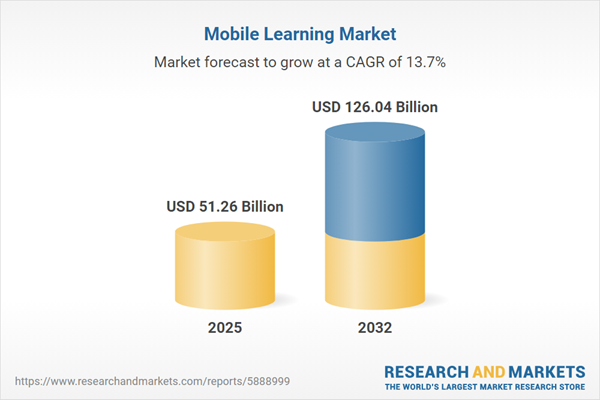Speak directly to the analyst to clarify any post sales queries you may have.
Mobile learning enables organizations to deliver professional training efficiently and adapt to evolving workforce needs. As organizations pursue large-scale digital initiatives, mobile-first learning strategies provide a flexible and accessible path for upskilling teams and promoting consistent standards across diverse workforces.
Market Snapshot: Mobile Learning Market Growth and Opportunities
The mobile learning market demonstrated robust growth throughout 2024 and 2025, reaching a total valuation of USD 45.00 billion supported by a compound annual growth rate (CAGR) of 13.73%. Increased adoption spans corporate, academic, and public-sector organizations as businesses seek real-time, device-driven learning solutions. Mobile learning supports dynamic team development by delivering adaptable skills training and compliance support in diverse environments. Its scalability is vital for organizations transitioning toward digital-first operations and workforce agility.
Scope & Segmentation: Mobile Learning Market Analysis
This analysis enables senior decision-makers to focus investment on strategic mobile learning segments and identify the most relevant deployment approaches for their organizational priorities:
- Component: Software platforms, learning management systems, content-driven digital solutions, hardware devices, and managed services organize, deploy, and support efficient learning programs enterprise-wide.
- Deployment Mode: Public, private, and hybrid cloud solutions as well as on-premises systems, accommodate a range of security, scalability, and operational continuity requirements during digital transformation.
- Learning Type: Self-paced modules, on-demand training resources, and interactive online sessions provide alternatives for flexible and scheduled learning, enabling alignment with varying user preferences and business workflows.
- Device: Access via personal computers, laptops, tablets, and smartphones ensures learning is accessible for hybrid, remote, and traditional work settings across global teams.
- End User: Solutions are tailored for corporate staff, government bodies, K-12 users, and higher education, supporting improved engagement, knowledge retention, and compliance management.
- Course: Academic, professional, and government-driven offerings address expertise development in regulatory, leadership, operational, and specialized industry domains.
- Region: The report analyzes trends across the Americas, Europe, Middle East & Africa, and Asia-Pacific, reflecting market maturity, infrastructure, and levels of digital integration unique to each region.
- Key Companies: Leading providers such as Coursera, Microsoft, Udemy, Skillsoft, Blackboard, Pearson, Duolingo, Pluralsight, John Wiley & Sons, and 2U address evolving enterprise learning requirements by offering scalable, interoperable solutions.
Key Takeaways for Senior Decision-Makers
- Artificial intelligence and analytics technologies enable customized learning paths and provide actionable insights for targeted workforce development planning.
- Embedding mobile learning into recurring workflows encourages ongoing skills advancement and drives sustained engagement in corporate learning programs.
- Addressing local and regional compliance, as well as cybersecurity demands, is crucial for long-term, effective mobile learning adoption and user trust.
- Collaboration with telecommunications enterprises, educational institutions, and content developers promotes broader access and accommodates varying learning needs and organizational cultures.
- Advanced analytics platforms continuously monitor workforce capabilities to identify skills gaps, supporting timely refinement of talent strategies as needs change.
Tariff Impact: United States Policy Changes in 2025
Recent policy adjustments in the United States have contributed to higher supply chain costs for mobile learning hardware and related components. In light of these changes, organizations are refining their vendor selection criteria, emphasizing transparency, value-driven partnerships, and flexible pricing to ensure continuity and compliance in workforce training.
Methodology & Data Sources
The research draws from extensive secondary data, comprehensive sector interviews, and targeted surveys of end users. This approach delivers practical insights to support executive decision-making on mobile learning investments and implementation.
Why This Report Matters to Your Business
- In-depth segmentation empowers organizations to align workforce strategies with specific industry context, compliance mandates, and deployment models that best fit operational requirements.
- Competitor benchmarking and analysis of technology trends inform practical procurement and help organizations direct investment toward growth and innovation.
- Strategic recommendations in the report facilitate global training consistency and help address evolving regulatory demands on corporate learning programs.
Conclusion
By applying these insights, leaders can fine-tune talent strategies, increase workforce resilience, and position their organizations to navigate ongoing change in the mobile learning landscape.
Additional Product Information:
- Purchase of this report includes 1 year online access with quarterly updates.
- This report can be updated on request. Please contact our Customer Experience team using the Ask a Question widget on our website.
Table of Contents
3. Executive Summary
4. Market Overview
7. Cumulative Impact of Artificial Intelligence 2025
List of Figures
Companies Mentioned
The companies profiled in this Mobile Learning market report include:- Coursera, Inc.
- Microsoft Corporation
- Udemy, Inc.
- Skillsoft, Inc.
- 2U, Inc.
- Blackboard Inc.
- Pearson PLC
- Duolingo, Inc.
- Pluralsight, LLC
- John Wiley & Sons, Inc.
Table Information
| Report Attribute | Details |
|---|---|
| No. of Pages | 197 |
| Published | November 2025 |
| Forecast Period | 2025 - 2032 |
| Estimated Market Value ( USD | $ 51.26 Billion |
| Forecasted Market Value ( USD | $ 126.04 Billion |
| Compound Annual Growth Rate | 13.7% |
| Regions Covered | Global |
| No. of Companies Mentioned | 11 |









